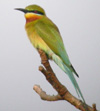
Real Birder
 |
Real Birder |
||||
| |
North Lincolnshire - 12th to 13th April 2007 |
|
Having never visited this area before, we decided to make an overnight stop south of the Humber Bridge and visit The Lincolnshire Wildlife Trust's Far Ings Nature Reserve in the hope of picking up both Bittern and Bearded Tit which breed there. We also visited the new reserve at Alkborough, created where the river's flood defences have been breeched, opposite the RSPB's Blacktoft Sands Reserve. ACCOMMODATION We chose Best Western Reeds Hotel at Barton upon Humber in view of its location. The hotel appears to be recently refurbished and fixtures and fittings are first class. Our room was a little on small side with double bed pushed up against one wall. It had been fitted out for disabled use and the bathroom area appeared to have been expanded at expense of bedroom size. Food was more than adequate, although a bit uninspiring, with a reasonable selection on evening menu. Breakfasts were good with an excellent choice and large portions. Alternate accommodation north of the Humber Bridge Premier Travel Inn Next to Home Farm Brewers Fayre. Looks OK and modern but is a basic Travel Lodge. Hotel Elizabeth Didn't get chance to have a look inside, but info can be found on the web site and either the Trip Advisor or uk-bookings web sites. SITES Far Ings reserve has a small Visitor Centre and toilet facilities, although a bit basic. The reserve is always open but the Visitor Centre only opens weekends 11.00hrs to 17.00hrs and Wednesday afternoons. There are two good hides, but the rest are old and very tired – oh, and small. Alkborough has a small car park but no other facilities. The access road is not signed but can be found from the centre of the village immediately left after the church, leading down a narrow road, then unmade track to the flooded fields and saltmarsh. Being in the area, we also visited Blacktoft Sands, just over the county border in Yorkshire and one of our personal favourites, which has all the facilities you would expect of an RSPB reserve. Also in the area and worth a visit later in the season, when the local breeding migrants have arrived, is Thorne Moor (with the adjacent Crowle Moor and Hatfield Moor) for Nightjar, Nightingale, Woodcock, Tree Pipit, Whitethroat, Grasshopper Warbler, Hobby and the elusive Long-eared Owl. BIRDING HIGHLIGHTS
We visited Far Ings in the late afternoon on 12th and early morning on 13th April and searched in vain for a visiting drake Garganey. We also missed out on Bittern and Bearded Tit. In fact, species wise, the site was a little disappointing. We saw the occasional Snipe, Marsh Harrier, Tree Sparrow and Bullfinch, but with only 35 species overall from two visits, it just wasn't our day (or two!).
SUMMARY 54 species in all over two days is not much to write home about, but we had visited two new sites and one old favourite and had enjoyed some fresh air and great weather. Bird Species Trip List (Excel) David & Amanda Mason |
| ©2012 Real Birder | Home • Photos • Trip Reports• Links • Contact Us |